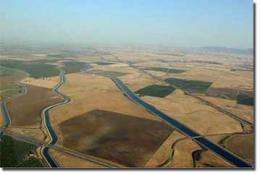Time's rising tide may swamp Delta marshes

While marshes in the Sacramento-San Joaquin Delta area are currently keeping pace with rising sea levels, they may not be sustainable under future sea-level increases.
The current rate of vertical soil formation or accretion may not be enough to keep rising marshes from being flooded in the future. These results are part of a new study in the January 2009 issue of the journal, Estuaries and Coast, by Lab scientist Tom Brown in collaboration with Judith Drexler and Christian de Fontaine of the U.S. Geological Survey.
Using the radiocarbon measurement capabilities of the Lab’s Center for Accelerator Mass Spectrometry, Brown analyzed macrofossils in peat soil samples to determine how quickly peat has formed over the past 6,700 years. At four of the marsh sites, peat has accreted from .03 to .49 centimeters per year.
Marshes form where hydrologic, geomorphic and ecological factors are conducive to the initial and continued buildup of mineral sediment and organic matter. In tidal freshwater marshes, this accrual of material results in the formation of organic, peat soils.
To date, most marsh studies looking at peat accretion rates have only focused on short timescales (from 10 years up to 100 years). But Drexler, de Fontaine and Brown suggest that more studies are needed that estimate peat formation processes over timescales that approach or incorporate the entire lifetime of a marsh. In this study, the timescale went back more than 6,000 years.
“Long-term rates at the millennial scale can provide a broader context for understanding the ability of marshes to continue providing crucial ecosystem services under scenarios of rising sea levels associated with global climate change,” Brown said.
The Delta contains a long continuous peat record, which makes it an ideal area for studying marsh levels for the last several millennia. The Delta, which is the landward limit of the San Francisco Bay Estuary, was once a 1,400-square-kilometer tidal marsh region that began forming about 6,700 years ago.
Between the 1860s and 1930s, the Delta was transformed by drainage and extensive levee building into an agricultural landscape with about 57 farmed islands and tracts. Drainage of marshes and subsequent oxidation of organic peat soils in the agricultural areas resulted in massive losses of soil and subsidence of the land surface up to eight meters below mean sea level.
Brown and his colleagues determined peat accretion rates over the past several thousand years to understand the vulnerability of the marshes to possible flooding from sea level rise.
“There have been studies on the peat distribution and thickness to date, but no one really knows exactly how peat started forming in the Delta and how quickly it has accreted through time,” Brown said.

Brown radiocarbon dated macrofossils found in the peat to determine the rate of peat accretion. The mean accretion rate in each marsh was well within the 0.1 to 0.2 centimeter estimated rate of sea-level rise during the past 6,000 years in the San Francisco Bay Estuary and very close to the estimated 20th century sea level rise of 0.17 centimeters per year.
However, sea level rise estimates for 2090-2099, from the Intergovernmental Panel on Climate Change, span a range of 0.15 to 0.97 centimeters per year and the central IPCC estimate of 0.38 centimeters per year is greater than the mean accretion rates for all the marshes in the study.
Although peat accretion rates in marshes have been known to increase to compensate for sea level rise, it is unclear whether the Sacramento-San Joaquin Delta marshes are capable of such large increases in accretion rates.
In addition, in the Delta region, there has been a decline in the amount of suspended sediment in the Sacramento and San Joaquin rivers due to upstream dam construction.
As sediment is an important component in the peat that forms in the marshes, declining sediment availability may make it even harder for Delta marshes to keep pace with future sea level rise.
Provided by Lawrence Livermore National Laboratory















